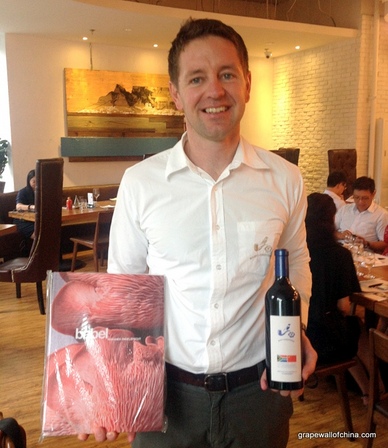
Charl Coetzee of Babylonstoren with one of winery’s cookbooks and a bottle produced to mark South Africa-China diplomatic relations.
By Jim Boyce
Dating to the seventeenth century as a farm, Babylonstoren — translation: Tower of Babylon — has recently emerged as a wine producer. This 400-hectare operation also grows a wide range of fruits and vegetables, including citrus and olives, and includes two restaurants, a bakery, a greenhouse and a produce store. I talked to wine maker Charl Coetzee ahead of a recent tasting at Pinotage restaurant and bar in Beijing.
On interest in the China market:
Babylonstoren has a long history but has just recently focused on wines. We started to produce a small quantity and to sell locally but the wines did quite will so we decided to export some of them. Our owner has good business ties in China and so we decided to do it here. Also, if you look at the wine market globally, China is attractive. That’s part of the reason for the decision, along with our owner’s love for China.
On market strategy:
In the beginning, there will be a big focus on Beijing. We also don’t want to go the traditional distributor route. We are busy setting up our own business, applying for our importer license. We will send wine from our own warehouses to customers, create our own distribution channels. We will sell in some restaurants but a major focus will be on-line retail and group buying.
On the use of Chinese by the winery:
If you come to Babylonstoren, you will see all of the signs on the farm written in English, Afrikaans and Chinese. This matches with our name, which refers to the Tower of Babel in The Bible. We are one of the few wineries in South Africa to do our signs in Chinese.
Our [Chinese-language] website was launched two years ago because we knew we were going to focus on the Chinese market. Everything big we do is in Mandarin. Our Babel restaurant cookbook will also be translated.
On facilities for visitors:
We definitely have an interest in tourists. We have a five-star farm hotel and spa. It’s a very popular property and was on Conde Nast Traveler’s Hot List 2011. We have had some Chinese delegates visit [usually connected to the owner’s business links].
On overall promotion of South African wine in China:
It is a matter of being persistent. WoSA [Wines of South Africa] is doing a lot all over the world. We were at the Yantai wine show [before Beijing] and tonight we have this dinner in Beijing.
[Get the free Grape Wall e-newsletter. See a sample here. To join the mailing list, use the form in the right sidebar or click here.]